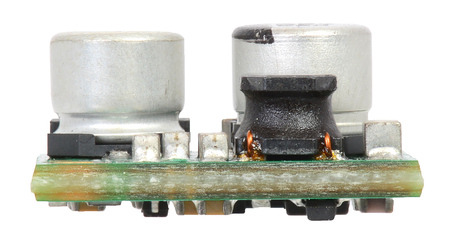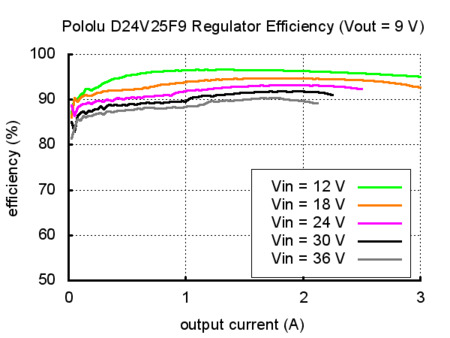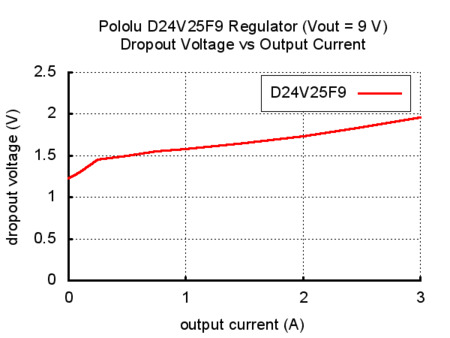Voltage Regulators and Power Supplies » Step-Down (Buck) Voltage Regulators » D24V25Fx Step-Down Voltage Regulators »
Pololu 9V, 2.5A Step-Down Voltage Regulator D24V25F9
| Output voltage | Typical max output current1 | Input voltage range2 |
|---|---|---|
| 9 V | 2.5 A | 10.5 V – 38 V |
Note 1: Typical continuous output current at 24 V in. Actual achievable maximum continuous output current is a function of input voltage and is limited by thermal dissipation. See the output current graphs on the product pages for more information.
Note 2: Minimum input voltage is subject to dropout voltage considerations; see the dropout voltage section of product pages for more information.
Alternatives available with variations in these parameter(s): output voltage Select variant…
 Compare all products in D24V25Fx Step-Down Voltage Regulators.
Compare all products in D24V25Fx Step-Down Voltage Regulators.
| Description | Specs (10) | Pictures (10) | Resources (3) | FAQs (0) | On the blog (1) | Distributors (7) |
|---|
Overview
 |
The D24V25Fx family of step-down voltage regulators generates lower output voltages from input voltages as high as 38 V. They are switching regulators (also called switched-mode power supplies (SMPS) or DC-to-DC converters) with typical efficiencies between 85% and 95%, which is much more efficient than linear voltage regulators, especially when the difference between the input and output voltage is large. The available output current is a function of the input voltage and efficiency (see the Typical efficiency and output current section below), but the output current can typically be as high as 2.5 A.
At light loads, the switching frequency automatically changes to maintain high efficiencies. These regulators have a typical quiescent (no load) current draw of less than 1 mA, and the ENABLE pin can be used to put the boards in a low-power state that reduces the quiescent current to approximately 10 µA to 20 µA per volt on VIN.
The modules have built-in reverse-voltage protection, short-circuit protection, a thermal shutdown feature that helps prevent damage from overheating, and a soft-start feature that reduces inrush current.
Several different fixed output voltages are available:
Alternatives available with variations in these parameter(s): output voltage Select variant…
The different voltage versions of this regulator all look very similar, so you should consider adding your own distinguishing marks or labels if you will be working simultaneously with multiple versions. This product page applies to all versions of the D24V25Fx family.
For newer step-down regulators with a similar input voltage range, output current, and size, consider the D24V22Fx family of regulators. Please note that while these D24V22Fx regulators look very similar to the D24V25Fx family of regulators, they do not have the same pinout and are based on a different internal design, so there are fundamental differences in operation. The D24V22Fx family also includes a 12 V option while the D24V25Fx family does not.
For higher-power applications, we carry a slightly larger, pin-compatible, 5 V version of this regulator that has a typical maximum output current of 5 A.
 |
Side-by-side comparison of the 2.5 A D24V25Fx (left) and 5 A D24V50F5 (right) step-down voltage regulators. |
|---|
Two even larger, higher-power, 5 V versions of this regulator are also available: one with a typical maximum output current of 6 A, and the other with a typical maximum output current of 9 A. The higher-power versions also have a few additional features, like a “power good” signal and the ability to lower their output voltage, and they include optional terminal blocks for easy removable connections.
Features
- Input voltage:
- 4.5 V to 38 V for the version that outputs 3.3 V
- [output voltage + dropout voltage] to 38 V for output voltages of 5 V and higher (see below for more information on dropout voltage)
- Fixed 3.3 V, 5 V, 6 V, 7.5 V, or 9 V output (depending on regulator version) with 4% accuracy
- Typical maximum continuous output current: 2.5 A
- Integrated reverse-voltage protection, over-current and short-circuit protection, over-temperature shutoff, and soft-start
- Typical efficiency of 85% to 95%, depending on input voltage and load; the switching frequency automatically changes at light loads to maintain high efficiencies
- Typical no-load quiescent current under 1 mA; can be reduced to 10 µA to 20 µA per volt on VIN by disabling the board
- Compact size: 0.7″ × 0.7″ × 0.35″ (17.8 mm × 17.8 mm × 9 mm)
- Two 0.086″ mounting holes for #2 or M2 screws
Using the regulator
Connections
This buck regulator has five connection points for four different connections: enable (EN), input voltage (VIN), 2x ground (GND), and output voltage (VOUT).
 |
The input voltage, VIN, powers the regulator. Voltages between 4.5 V and 38 V can be applied to VIN, but for versions of the regulator that have an output voltage higher than 4.5 V, the effective lower limit of VIN is VOUT plus the regulator’s dropout voltage, which varies approximately linearly with the load (see below for graphs of dropout voltages as a function of the load).
The output voltage, VOUT, is fixed and depends on the regulator version: the D24V25F3 version outputs 3.3 V, the D24V25F5 version outputs 5 V, the D24V25F6 version outputs 6 V, the D24V25F7 version outputs 7.5 V, and the D24V5F9 version outputs 9 V.
The regulator is enabled by default: a 100 kΩ pull-up resistor on the board connects the ENABLE pin to reverse-protected VIN. The ENABLE pin can be driven low (under 0.6 V) to put the board into a low-power state. The quiescent current draw in this sleep mode is dominated by the current in the pull-up resistor from ENABLE to VIN and by the reverse-voltage protection circuit, which will draw between 10 µA and 20 µA per volt on VIN when ENABLE is held low. If you do not need this feature, you should leave the ENABLE pin disconnected.
 |
Pololu 2.5 A Step-Down Voltage Regulator D24V25F5 (5 V) or D24V25F3 (3.3 V) with included hardware. |
|---|
The five connection points are labeled on the top of the PCB and are arranged with a 0.1″ spacing for compatibility with solderless breadboards, connectors, and other prototyping arrangements that use a 0.1″ grid. Either the included 5×1 straight male header strip or the 5×1 right angle male header strip can be soldered into these holes. For the most compact installation, you can solder wires directly to the board.
 |
Pololu 2.5A Step-Down Voltage Regulator D24V25Fx, side view. |
|---|
The board has two 0.086″ mounting holes intended for #2 or M2 screws. The mounting holes are at opposite corners of the board and are separated by 0.53″ both horizontally and vertically.
Typical efficiency and output current
The efficiency of a voltage regulator, defined as (Power out)/(Power in), is an important measure of its performance, especially when battery life or heat are concerns. This family of switching regulators typically has an efficiency of 85% to 95%, though the actual efficiency in a given system depends on input voltage, output voltage, and output current. See the efficiency graph near the bottom of this page for more information.
The maximum achievable output current is typically around 2.5 A, but this depends on many factors, including the ambient temperature, air flow, heat sinking, and the input and output voltage.
Typical dropout voltage
The dropout voltage of a step-down regulator is the minimum amount by which the input voltage must exceed the regulator’s target output voltage in order to ensure the target output can be achieved. For example, if a 5 V regulator has a 1 V dropout voltage, the input must be at least 6 V to ensure the output is the full 5 V. Generally speaking, the dropout voltage increases as the output current increases. See the “Details” section below for more information on the dropout voltage for this specific regulator version.
Switching frequency and behavior under light loads
The regulator generally operates at a switching frequency of around 600 kHz, but the frequency drops when encountering a light load to improve efficiency. This could make it harder to filter out noise on the output caused by switching.
Details for item #2854
The graphs below show the typical efficiency and dropout voltage of the 9 V D24V25F9 regulator as a function of the output current:
During normal operation, this product can get hot enough to burn you. Take care when handling this product or other components connected to it.
The over-current limit of the regulator operates on a combination of current and temperature: the current threshold decreases as the regulator temperature goes up. However, there might be some operating points at low input voltages and high output currents (well over 2.5 A) where the current is just under the limit and the regulator might not shut off before damage occurs. If you are using this regulator in an application where the input voltage is near the lower limit and the load could exceed 3.5A for sustained periods (more than five seconds), consider using additional protective components such as fuses or circuit breakers.
People often buy this product together with:
 |
Pololu 5V, 2.5A Step-Down Voltage Regulator D24V25F5 |
 |
Pololu 5V, 5A Step-Down Voltage Regulator D24V50F5 |
 |
Pololu 7.5V, 2.5A Step-Down Voltage Regulator D24V25F7 |



























